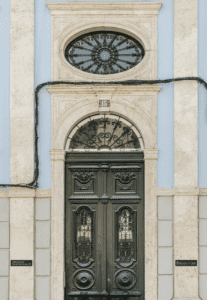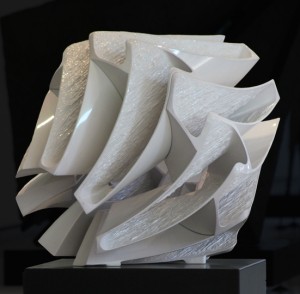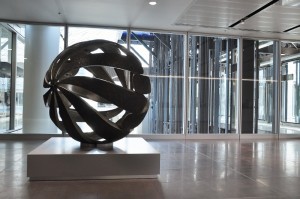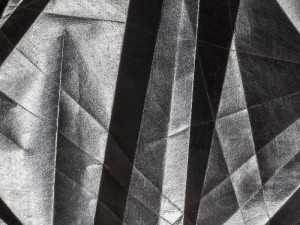
Charley Peters – _MG_2332, Pigment Print, Edition of One, 2013
1 Have you always felt yourself an artist?
Yes, when I think back to when I was a child I used to spend most of my time drawing, reading or writing. These are the things that I still spend most of my time doing now as a profession; I never had any desire to do anything else. Even when I’ve had other jobs in the past they have always been temporary and/or part-time to allow me enough time to make my work, that’s been very important to me. I’m extremely lucky to have found something that I love doing every day.
2. Can you tell us more about your work and what are the main ideas you would like to express?
I don’t see my work as an attempt to express any ideas as such. It feels more investigative; an exploration of materials, processes or spaces. I think that my work is creative within a logical framework, involving the testing of specific media or application of systems of generating work, such as repetitive drawing techniques or methodically folding paper. Mostly my work is made in my studio and is developed in a linear way – one piece of work leading to another. My work sits within what I describe as ‘the expanded field of drawing’; it’s concerned with the generation and consideration of lines in a given space. I often use simple materials like graphite and paper to make my work, but also extend the investigations started in drawings into other media such as photography and paint. These works are sometimes a documentation of my drawings or a development of concerns that have emerged through the process of making earlier works. My most recent work has developed from a residency I undertook at The Centre for Drawing, University of the Arts London, where I was interested in responding to the quality of light in the studio I was given. From then I’ve been developing densely worked graphite surfaces that form a reflective surface when polished and folded. They have become quite sculptural and suggest that a drawing can be a surface or object as well as a mark on a piece of paper. I find this shifting relationship between surface, image, object and architectural intervention very interesting.
3. How do you start the process of making work?
I start at the point at which my last work finished. Everything that I make seems to suggest further possibilities for future work, so I never feel lost for ideas or inspiration. I archive sketches and experiments from the studio on a blog (charleypetersprojects.com), which I have found is a good way to see the progression of my work and to record ideas so I can return to them later. I use sketchbooks a lot too, but these are much less organised and develop organically in sync with my many (often conflicting) ideas about the work I should make next. They help me to ‘see’ where the work could go next and to answer questions I may have about its scale, materials and presentation. There’s a text that I find very inspiring and that I think illustrates well the anxieties that can surround the making of a new piece of work for many creative people, and a positive strategy for getting on with creating work without fear of failure: Sol LeWitt’s letter to Eva Hesse, written in 1965 (http://jwvpk.wordpress.com/2009/03/10/letter-from-sol-lewitt-to-eva-hesse/).
4. Do you consider the viewer, when making your work?
Not at the time of making the work. At that point the experience is about my relationship with the materials I’m using and the thoughts that I have while working. The viewer becomes more of a consideration for me when the work is being exhibited, then I think very carefully about how people will encounter the work in a physical space. My work is often spatially engaged so the installation of it is important. I think about the space within the surface of the drawing and also the space that the drawing occupies once it leaves the studio and starts being something for other people.
5. Name 3 artists that have inspired your work.
I admire Eva Hesse for her innovative approach to material exploration and lack of fear about the ephemeral quality of some of her work. I respect the purity and integrity of Nasreen Mohamedi’s drawings, and Mary Martin’s precise, systematic approach to exploring line and space. I love what Mary Martin wrote about the precision of her work, by means of counteracting a view of her work as impersonal, ‘In the mechanics of art precision is essential to expressiveness. I mean precision of choice not dry academic precision… experience shows that in many things, precision is the property of the hand rather than the machine.’ I completely relate to her sentiment, that choosing to work with materials in a considered, controlled way is as much a form of expression as more gestural ways of making marks.
6. What defines something as a work of art?
I can’t offer a definitive answer to this…
For me a work of art might challenge my thinking, it might make me see things in a new way, it might effect my emotions, it might do all of these things or something else entirely. I can’t easily say what a work of art is for anyone other than me, but I think we probably all know when we see one!
7. Why are you having this exhibition now?
I was invited to take part in the exhibition by Encounter and it sounded like a great opportunity to explore my work in a different space.
In some ways, as the exhibition exists only in a digital environment, it is located in a non-space and I found this idea very engaging.
8. How did you get to work with Encounter and why is the exhibition online only?
Encounter and I met on Twitter and our conversation about working together grew from there. I was very interested in the way they use non-traditional gallery spaces to host exhibitions, the digital environment being one of these spaces. For me working with Encounter offers an opportunity for my work to be seen in different locations, the way my work relates to architectural spaces is sometimes part of the work itself so this has many exciting possibilities in terms of practice developing in the future. I’m especially interested in how the experience of physical work translates to a virtual environment so am very much looking forward to seeing Liminality when it opens.
10. What plans do you have to continue to pursue your art career in 2014?
My next project is an exhibition at Z20 Sara Zanin Gallery in Rome
See Charley Peters online Exhibition with Encounter Fine Art and Exhibbit opening this Thursday 7pm HERE









